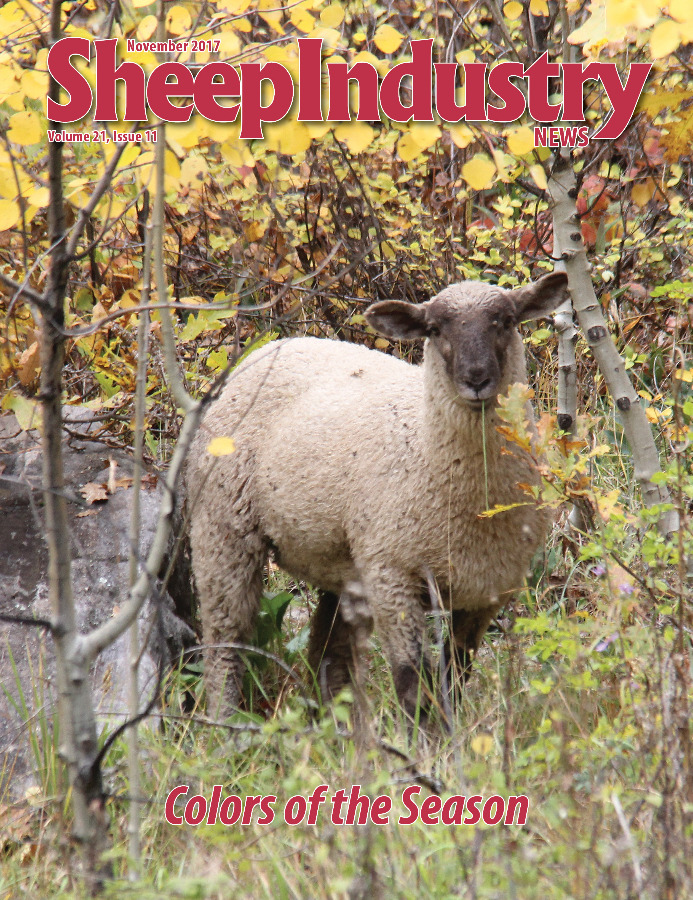
- November 2017
- President’s Notes
- NSIP, Breeds Find Common Goals
- NSIP Adds Searchable Database
- Sheep Prove More Reliable than Weather in Bayfield
- Cestari Hoping to Rebuild Wool Sheep Numbers Back East
- Tips for Culling & Selecting Ewes
- Young Entrepreneur: Katie Forrest
- Obituaries
- Around the States
- Market Report
- The Last Word
Tips for Culling & Selecting Ewes
HEATHER LORAAS
Wyoming Livestock Roundup
Selecting replacement ewes can be a confusing process that leaves producers with a lot of questions and concerns about making the right decision, according to University of Maryland Extension Sheep and Goat Specialist Susan Schoenian.
On Oct. 3, the ASI’s Let’s Grow Committee hosted a webinar titled Replacement Ewe Selection and Culling of Underperforming Ewes to help producers make decisions. The event, hosted by Jay Parsons of the University of Nebraska-Lincoln Department of Agriculture Economics and Schoenian, provided advice producers can use for their own operations.
Schoenian states the first step in ewe selection is determining goals for the operation because everyone is different.
“Producers need to identify the strengths and weakness within the flock, as well as areas they want to improve without compromising other traits,” Schoenian states.
Once goals are determined, there are two paths producers can choose from – single trait or multiple trait selection. Single trait selection is often the quickest way to fix a single problem, but Schoenian said there are often unintended and negative results. She recommended selecting for multiple traits because multiple traits affect the profitability of a sheep operation.
“At the same time, producers should be careful not to select for too many traits at one time,” she added.
There are three selection methods producers can use, she said. First is tandem selection, which is selecting a trait until a certain level of performance is reached before moving on to the next trait.
“An example might be selecting for parasite resistance in the flock and then moving on to growth or reproduction,” she said.
Independent culling levels is another popular selection method. Schoenian stated ICL works by setting minimum standards for multiple traits and the flock.
“It’s not about selecting for the fastest growth or the best parasite resistance but selecting animals that meet producers’ minimum standards,” she added.
The last selection method is using selection indexes, which weighs traits relative to their economic importance within the flock. Schoenian said sometimes the selection indexes should change because price relationships have changed. Indexes help producers achieve their goals of balancing their selection.
Producers must first decide whether to buy or raise replacement ewes, said Schoenian.
Buying replacements is sometimes easier because producers can sell lambs as premier market lambs, purchase specialized replacement females or buy mature ewes. It can also be cheaper to buy ewes rather than raising them, she explained.
When buying replacement ewes, the most important consideration is health.
“In turn, the biggest advantage to raising replacement females is biosecurity control,” Schoenian stated.
Raising replacement ewes allows for a closed flock, which greatly reduces disease risks. Biosecurity is very important on a sheep operation because most diseases are brought into an operation through other animals, she stated.
Older ewes are also an option for replacement or expansion, Schoenian said.
“I think people tend to want to buy yearling ewes, but they aren’t as available. The few out there are usually purchased quickly,” she said.
Some criteria for selecting replacement ewes include performance, genotype and visual appraisal. Schoenian said the best way to select females is a combination of the criteria.
Performance evaluation is key, and females need to be selected on the basis of performance records. A female can be selected using her individual performance, pedigree and breeding values, according to Schoenian, depending on producer needs.
Producers can also select ewes by genotype to reduce the risk of having certain diseases or genetic defects, according to Schoenian.
“This can be a selection factor for producers who are trying to get rid of diseases in their flock or set certain health standards,” she stated.
Once producers have identified the animals on paper, they need to be visually appraised, she said. The animals need to be structurally correct, reproductively sound and without any defects. She pointed out that performance records don’t indicate structure or soundness issues.
“Some visual traits can affect longevity and the ability to thrive in an environment,” she added.
Starting with structure, Schoenian said prospects should be looked at from multiple angles and when walking. Ewes should not be pigeon-toed or splay-footed, and their legs shouldn’t be too straight or bowed.
“Producers should also check for under-bites and overbites, which can affect the ewe because these are very hereditary traits and usually get worse with time,” said Schoenian.
Reproductive soundness should be considered for ewes. Producers should look at the number, size and placement of teats. Having too many, too large or misplaced teats can cause problems later on.
In terms of the udder, ewe lambs don’t usually show anything, but mature ewes need to have high, soft and functional udders.
“The key is for the ewes to have sound mouths, sound udders and be structurally correct,” Schoenian stated.
Selecting for conformation in size, length and volume depends on the breed of the animal and is also important for producers to consider. Minimum standards should be used to avoid any extremes in structure, reproductive soundness and conformation.

